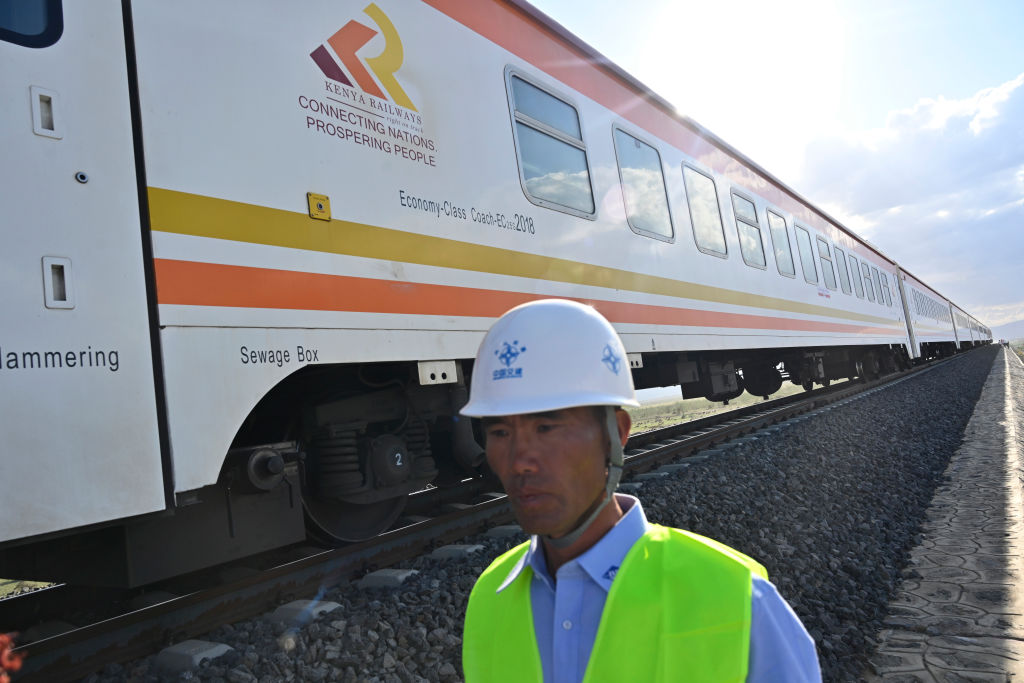Kenyans called it the “railway to nowhere” years before the phrase took on a literal meaning. Today, the end of the line for the vaunted Chinese-built Standard Gauge Railway (SGR) sits unused in a cornfield in the Rift Valley, about 468 kilometers short of its goal of reaching the Ugandan border.
The SGR was supposed to be an economic boon for East Africa, stretching from Mombasa and Nairobi all the way to Uganda with plans to link up with Burundi, the Democratic Republic of the Congo, Rwanda and South Sudan.
“The reality of what remains the single-largest infrastructure program Kenya has ever embarked upon has fallen spectacularly short of its grand ambitions,” Associate Editor Ben Marlow of the The Telegraph wrote from Nairobi for a September 3 article.
“Far from symbolizing Kenya’s emergence as a regional powerhouse, the SGR has become an embarrassing monument to a debt crisis that threatens to engulf a continent which is now hooked on loans from Beijing.”
From 2000 to 2023, Kenya’s total debt to China was $9.6 billion — fourth largest among African nations, behind only Angola, Ethiopia and Egypt — according to the Chinese Loans to Africa Database.
Kenya spends nearly $8 million per month to operate the SGR, according to Ministry of Roads and Transport data. That figure doesn’t include an ever-growing mountain of debt to the Chinese banks that financed 90% of the railroad’s construction.
On average, Kenya spends more than $1 billion per year to service its SGR debt to China. Kenya’s biggest external debt holder is China Exim Bank, to which it owes $741 million in principal, $222 million in interest and $41 million in penalties for the 2025-2026 fiscal year.
Kenyan Auditor-General Nancy Gathungu revealed those figures in a July report that was met with shock and outrage.
“These penalties expose the public to expenditures that could otherwise have been avoided,” she wrote. “This expenditure is not a proper charge to public funds.”
SGR payments to China in July accounted for more than 81% of Kenya’s total foreign debt service. Nairobi-based journalist Juma Majanga estimated that Kenya’s debt-servicing costs this year equate to about 67.1% of the country’s revenue, which is well above the threshold of 30% recommended by the International Monetary Fund (IMF).
“Continuous borrowing for large infrastructure projects may project an image of a fast-growing economy but in the long run might expose future generations to debt saturation,” he wrote in an August 12 opinion piece for Capital FM Business.
“This is technically a point where Kenya might max out its borrowing capacity due to high existing debt levels relative to national income, assets or ability to repay, making further borrowing unstainable or prohibitively expensive.”
In 2014 and 2015, Kenya secured two loans worth about $5 billion to build the 480-kilometer railway connecting the busy port of Mombasa with the capital, Nairobi, and a 120-kilometer extension to Naivasha in the Central Rift Valley.
It was part of China’s Belt and Road Initiative (BRI), a state-backed global infrastructure investment scheme. After a five-year grace period, Kenya resumed repaying its SGR debts in 2019.
The long-delayed next phase of the project, from Naivasha to Malaba on the Ugandan border, is estimated to cost another $5 billion. The government announced in July that it will transfer operations of the extension to private investors.
“The last 40% of the SGR line will be built by a consortium of Chinese companies,” Kenyan Treasury Cabinet Secretary John Mbadi recently told Parliament. “They will charge for the use of the railway line.”
The BRI has turned China into the world’s biggest debt collector. Analysts say Beijing now favors an “extend and pretend” strategy to deal with debt owed by developing countries.
Chinese banks have made a practice of postponing or delaying debt defaults, extending loan maturities and disguising systemic problems as issues of temporary liquidity. However, experts say China’s debt-servicing policies risk creating a system of hidden debt and long-term financial hardships that typically lead to larger restructurings.
The IMF in March classified Kenya at a high risk of debt distress, suspending the final review of its program with the country, which left the government without access to a final loan disbursement of nearly $850 million.
David Omojomolo, an Africa specialist at research consultancy Capital Economics, said other heavily China-exposed borrowers such as Angola are keeping a close eye on Kenya.
“Without IMF support and meaningful fiscal consolidation, the country’s debt trajectory remains unsustainable,” Omojomolo told The South China Morning Post newspaper. “Kenya may muddle through in the short-term, but its ability to service its obligations will remain strained, leaving sovereign default risks elevated.”
Jimi Wanjigi, a prominent Kenyan businessman and government critic who plans to run for president in 2027, believes his country will end up paying more than double the SGR’s original price tag.
“It [the SGR] was one of the biggest cons we have ever seen, the beginning of a long fraud on Kenyans,” he told The Telegraph. “It laid the foundation for what I call the ‘debt heist.’”

